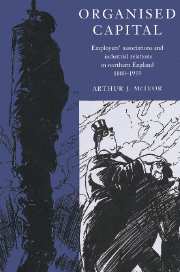Book contents
- Frontmatter
- Contents
- List of maps and tables
- Acknowledgements
- List of abbreviations
- Introduction
- Part 1 Setting the scene
- Part 2 Forging employers' organisations, 1880–1920
- 3 Organisation, membership and solidarity
- 4 Strikebreaking
- 5 Collective bargaining and procedural control
- 6 The impact of the First World War
- Part 3 Reacting to the economic slump, 1920–39
- Conclusion
- Bibliography
- Index
3 - Organisation, membership and solidarity
Published online by Cambridge University Press: 14 October 2009
- Frontmatter
- Contents
- List of maps and tables
- Acknowledgements
- List of abbreviations
- Introduction
- Part 1 Setting the scene
- Part 2 Forging employers' organisations, 1880–1920
- 3 Organisation, membership and solidarity
- 4 Strikebreaking
- 5 Collective bargaining and procedural control
- 6 The impact of the First World War
- Part 3 Reacting to the economic slump, 1920–39
- Conclusion
- Bibliography
- Index
Summary
As noted in chapter I, a significant strand of research upon employers' organisations emphasises the persistence of disunity, fragmentation, and fractured collective consciousness amongst British employers prior to the First World War. According to this interpretation, employer combinations in Britain before 1914 lacked centralised control and authority over their members, were unable to develop a consensus labour relations strategy, or significantly influence the existing division of labour. Initiatives towards employer solidarity before the First World War thus generated weak, fragile alliances which were short-lived and episodic, the removal of the immediate threat leading inevitably to a rapid fracturing in cohesion, undermining employer organisation. Roy Bean's case study of Liverpool shipping provides one such example of a strong employer association critically weakened by breakaways after the threat from the dockers and seamen subsided. Indeed, the Employers' Labour Association in Liverpool haemorrhaged from covering fifty major shipping lines in 1890 to just thirteen in 1909. But was this experience typical or exceptional in this period?
This chapter investigates the organisational structures which employers collectively constructed, evaluates membership trends and employer solidarity within associations and elaborates a little on the services offered by such institutions. How strong and cohesive were employers' associations before 1914? How were they organised? Who were members? What were the forces which stimulated collective organisation? It will be argued here that the interpretation presented above has important merits, especially in dispelling the myth of a monolithic employer class.
- Type
- Chapter
- Information
- Organised CapitalEmployers' Associations and Industrial Relations in Northern England, 1880–1939, pp. 59 - 91Publisher: Cambridge University PressPrint publication year: 1996



